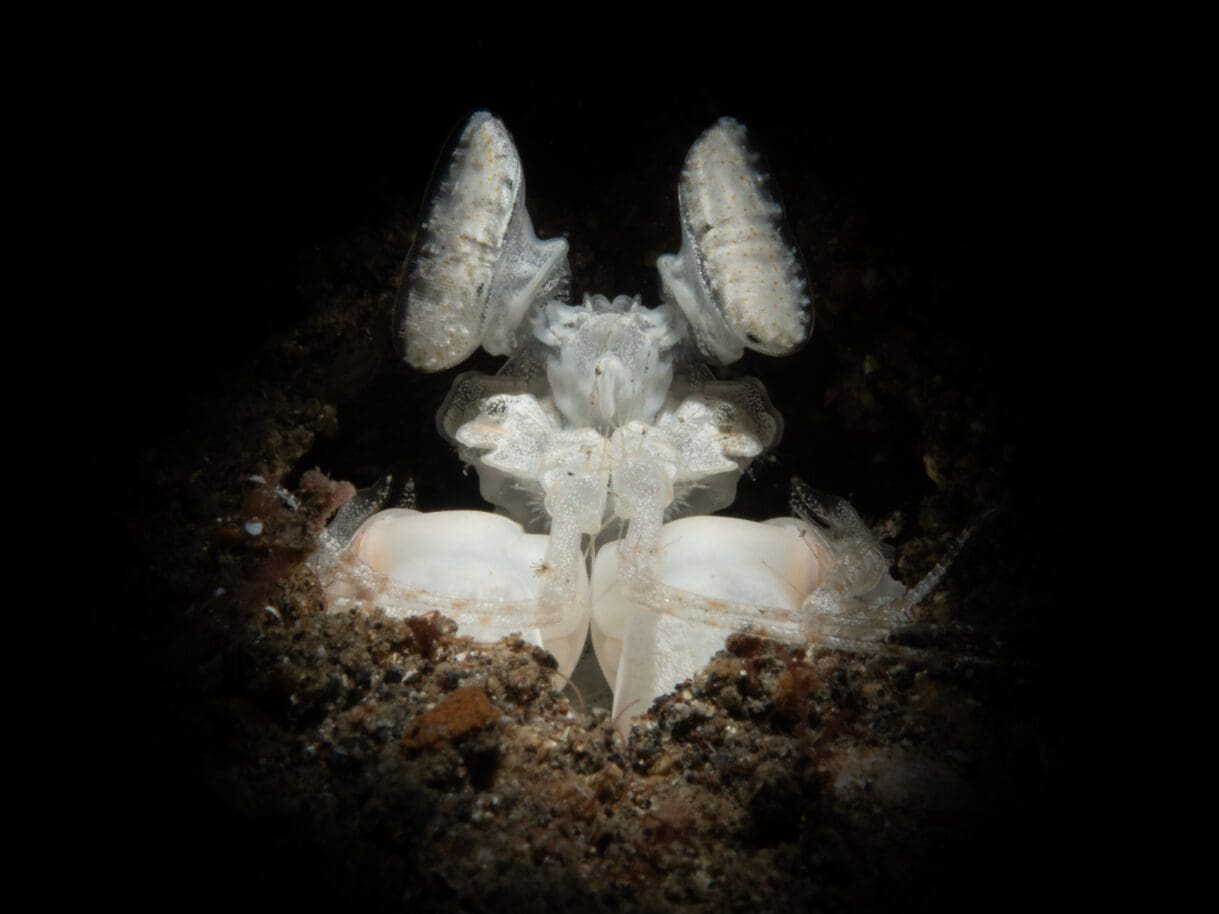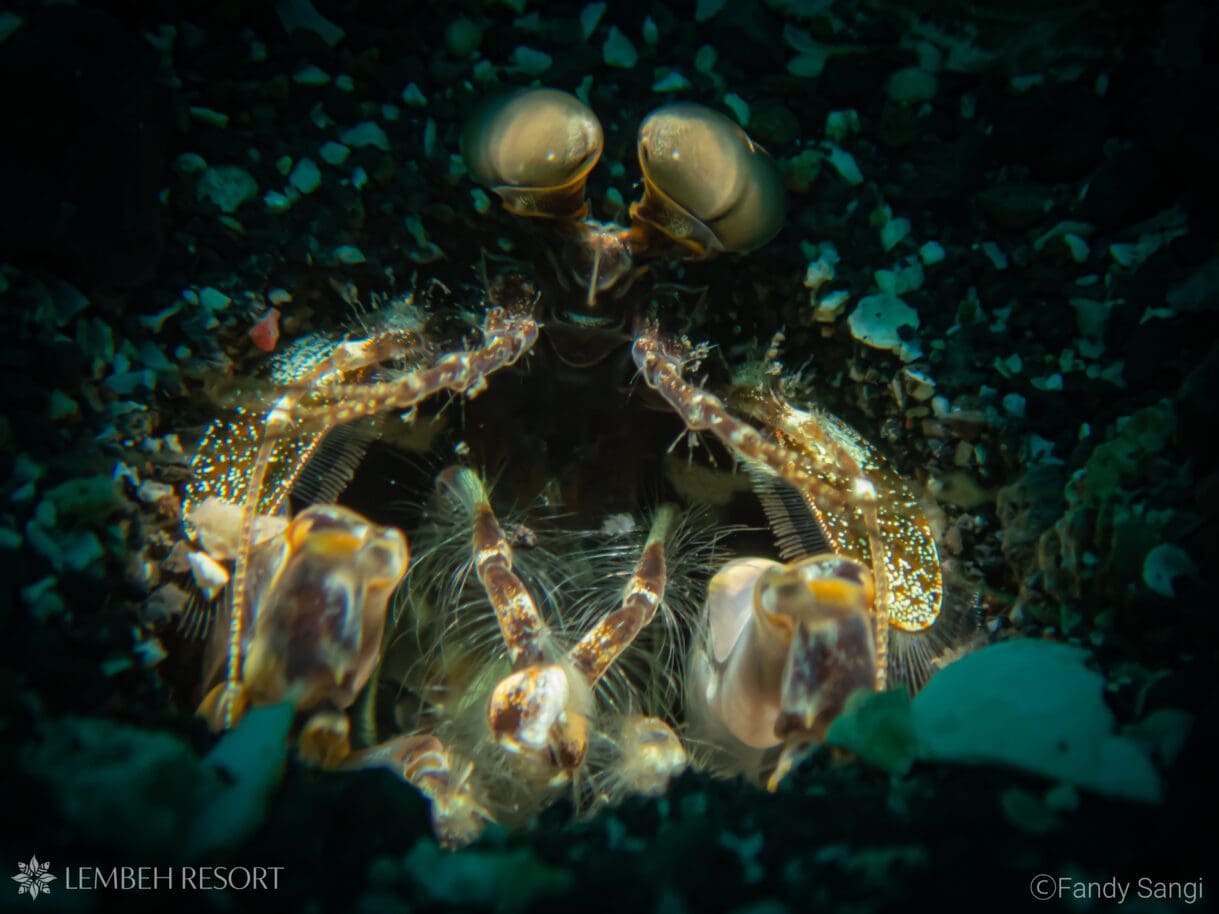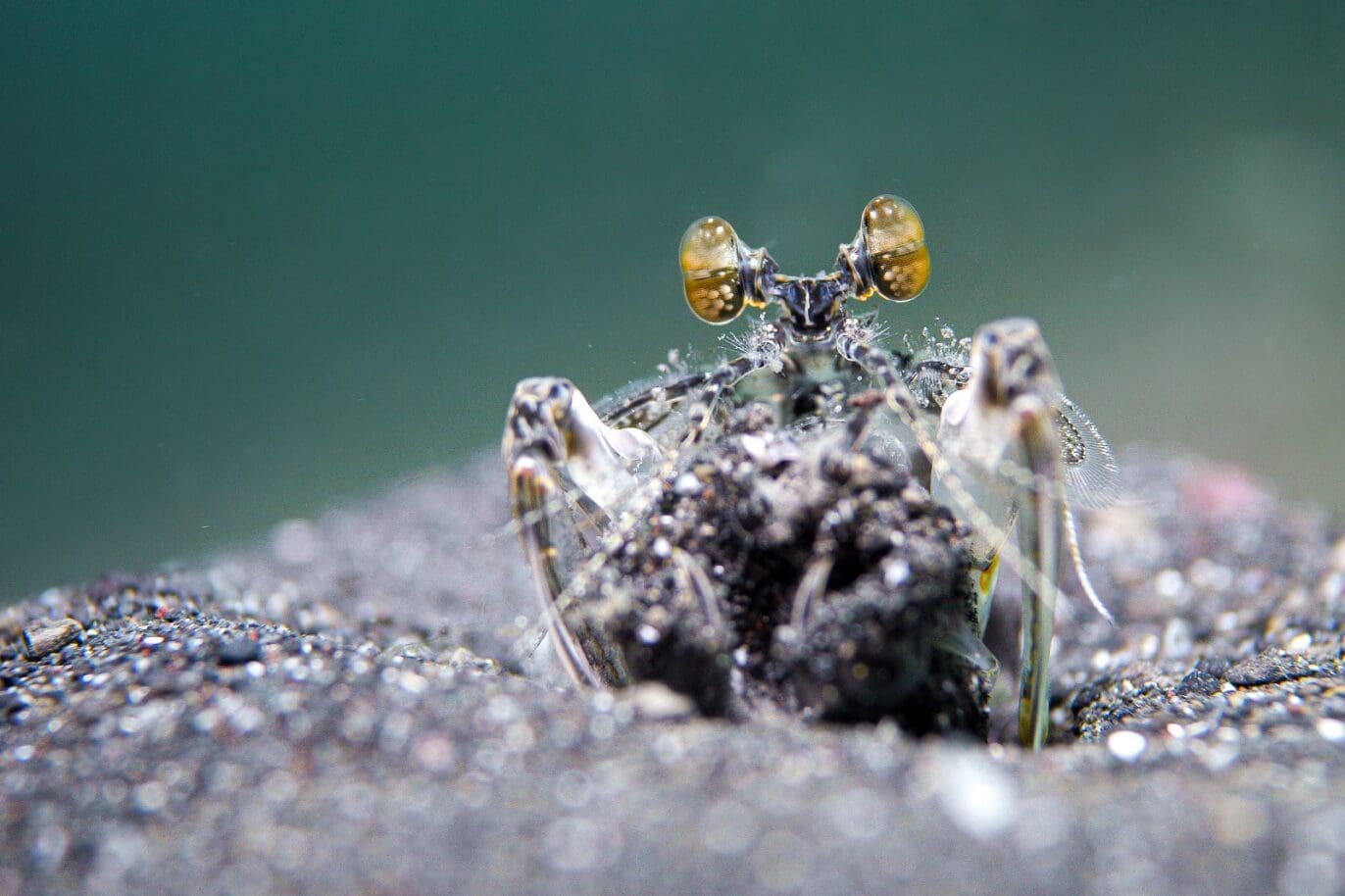Colors and Combat: Exploring the Tiger Mantis Shrimp in Lembeh
For those of you who have been diving in Lembeh Strait, you may already know how powerful and violent mantis shrimps can be, either spearing or smashing prey and pretty much anything else that gets in their way. Perhaps you have already heard that they have the most advanced eyes in the entire animal kingdom or can smash with the same force as a 9 calibre bullet being fired from a pistol?
Although we have several species of mantis shrimp in the Lembeh Strait, in this Blog we take a look at one particularly special species – the tiger mantis shrimp.
Physical Characteristics of the Tiger Mantis Shrimp

Tiger Mantis
Tiger mantis shrimps are scientifically known as Lysiosquillina maculate, other common names include the zebra or giant mantis shrimp. They are a larger species of mantis shrimp and can grow up to 40cm / 15 inches long. Their bodies are covered in overlapping armor-like plates that alternate in color between a pale beige/cream to white and a reddish brown or tan color (this striped pattern explains their common names of tiger or zebra).
Tiger mantis shrimp are spearing mantis shrimp and they are equipped (or weaponized!) with raptorial appendages and spiny appendages – the spines having barbed tips – used to stab and snag prey.
Adaptations: EyeSight
The eyes of the mantis shrimp are mounted on mobile stalks and can move independently of each other. The extreme mobility allows them to be rotated in all three dimensions. They are thought to have the most complex eyes in the animal kingdom and have the most advanced front end for any visual system ever discovered. Compared with the three types of photoreceptor cells that humans possess in their eyes, the eyes of a mantis shrimp have between 12 and 16 types of photoreceptor cells.
Mantis shrimp can see a variety of different light forms including infrared and ultraviolet light. Mantis shrimp eyes also have the unique ability to perceive circularly polarized light – a form of light that no other animal can see. In addition to these visionary capabilities, when mantis shrimps mate their bodies fluoresce with a light that only other mantis shrimp can see.
Habitats and Distribution in Lembeh

In the Lembeh Strait, at the best of times for diving we saw mantis shrimp at all depths ranging from 3 – 30 meters. Smashers tend to live on harder substrates such as coral rubble and reefs. Spearfish species like the tiger mantis shrimp prefer to live on softer sandy bottoms that are easier to burrow into.
Reproduction
Tiger mantis shrimp has the same unique facts as other mantis shrimp species. They are monogamous and usually mate for life, a rare trait in the animal kingdom. These creatures can live up to 40 years and have been known to remain with the same partner for in excess of 20 years!
What if something happens to the male? According to leading ichthyologists and experts on stomatopods, if the male disappears (perhaps a victim of predation), the female will advertise her newly found availability by making a noise, similar to what a cricket makes, to attract a new male.
The size of the female determines the particular frequency of the noise she emits. Larger females are often sought out by males because a larger female can produce more eggs. The female will continue to ‘sing’ until she attracts a new mate.
In a lifetime, tiger mantis shrimps can have as many as 20 or 30 breeding episodes and females can lay up to 100,000 eggs. Females are the primary caretakers of the eggs – either in the burrow or under her tail while the male will take care of hunting for the pair.
Tiger Mantis Shrimp Photography

Tiger mantis shrimp are shy and secretive burrowers and most sightings are of the male’s head protruding from its burrow – it is unusual to spot a tiger mantis shrimp out in the open. It is important to approach slowly and with caution so as not to spook the shrimp causing it to retreat back into the burrow. Aim to position yourself close to the bottom – the higher up you are, the bigger you will appear and the greater the perceived threat. As with most critters in the Lembeh Strait, stay low and go slow!
Tip: Aim to get as close as you can and avoid using the digital zoom function which will result in a more grainy and pixelated image. If you are able to approach in increments and take shots at each stage, if the mantis does retreat, you will still have a flow of images to work with during post-shooting editing.
Behavior and Feeding
Mantis shrimp live together in pairs in long (up to 10 meters/30 ft), U-shaped burrows where the female hides underground and the male waits at the entrance for soft prey, which is easiest to spear, to pass by. When a potential victim is within reach, the male will strike out and spear it with its spiny raptorial appendage. The male then takes the prey into the burrow for the female to feed on first.
What a gentleman, you’re thinking! Females have much smaller eyes and arms and are essentially ‘barefoot and pregnant’, ill-equipped to hunt or fend for themselves, and are therefore dependent on their male counterparts for survival.
Variety of Species
The Lembeh Strait is renowned for its abundance of crustaceans, and other species of mantis shrimp that you may spot while diving with us include the smashing peacock mantis shrimp (Odontodactylus scyllarus), the spearing golden mantis shrimp (Lysiosquilloides mapia), and the smaller smashing pink eared mantis shrimp (Odontodactylus latirostris).
Stay and Dive With Us

If you are ready to book your stay too see the wonderful Tiger Mantis with us at Lembeh Resort or would like more information about our rates and availability contact us at reservations@LembehResort.com.
Our reservations team looks forward to assisting you!
Further Reading
If you enjoyed reading this article, you may also enjoy some of our other articles about the unique marine life found here in the Lembeh Strait:


